#They gave knitting patterns to a neural network to get it to make knitting patterns
Explore tagged Tumblr posts
Text
I feel like SkyKnit needs to be taught as an example of why “AI” isn’t real ‘intelligence’ and why it can’t replace humans. Like people try to explain it in all sorts of ways but you could just explain SkyKnit instead. plus there’s cool knitted items to show as you explain
#artificial intelligence#ai#skyknit#They gave knitting patterns to a neural network to get it to make knitting patterns#It knew what the pattern entailed. It repeated all the right letters and numbers#And it made completely impossible patterns because it didn’t know what knitting was#There’s a pattern to patterns but it couldn’t make a pattern!#I wonder what would happen if you asked the new AI to make a knitting pattern
4 notes
·
View notes
Text
First there was SkyKnit. Now there's HAT3000
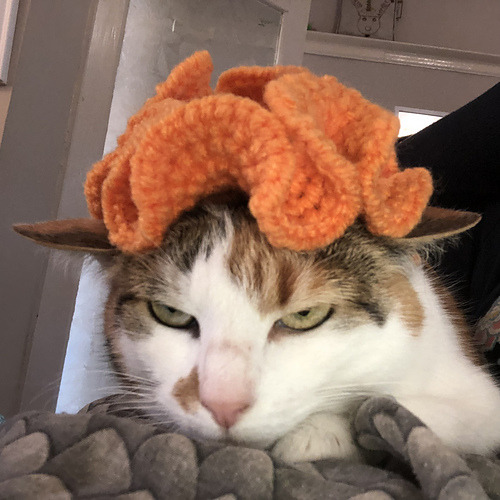
[Chunky Hat”, crocheted by Joannastar]
A while ago, I tried to train a neural network to generate knitting patterns by showing it a few thousand existing patterns so it could use trial and error to generate new patterns. I called the project SkyKnit, and its new patterns were… well, they were patterns. But they were nothing like the patterns it had been trained on. The test knitters of Ravelry’s adults-only, often-indecorous LSG forum had to do a lot of debugging to turn them into reality and, even debugged, SkyKnit’s patterns were strangely organic, prone to weird branching ribbing and organic-looking holes, turning into irregular shapes or even tentacles.
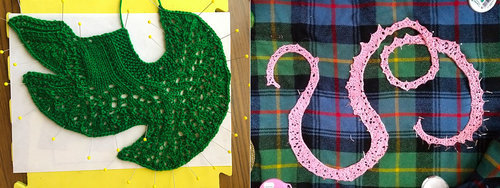
[Make Caows and Shapcho, knitted by MeganAnn, and Lacy 2047, knitted by michaela112358]
Ever since the SkyKnit project, I’ve wanted to do a version for crochet. Like knitting, crochet has strong ties to mathematics and programming, and in many ways it’s more flexible. A crochet algorithm could potentially create even more exotic shapes than SkyKnit did.
For this project, to be dubbed HAT3000, I decided to make some improvements. I would train it on just crochet hats, which ought to be simple enough and similar enough that a neural net might be able to figure out the general pattern and produce functional designs. The LSG forum crocheters helped me assemble training data of 500 vintage out-of-copyright patterns, plus these kind designers contributed their own patterns to the effort: krisitis-patterns, irishlacenet, SierraPelona, fairyhedgehogg, watrpriestess, RachyNewin, agnosticnun, UnplannedCauli, membril, Moogly, and SuviCrochets.
I used Max Woolf’s gpt-2-simple collab notebook to finetune OpenAI’s GPT-2-355M neural net model. It’s pretrained with a bunch of non-crochet knowledge from the internet (fanfiction, recipes, conspiracy theories), but it does have a much longer memory than SkyKnit does, so will have a better chance of being able to figure out how the rows relate to one another. HAT3000 was set up for success.
My first indication that something was going wrong was when the hats kept exploding into hyperbolic super-surfaces.
A pattern would start modestly enough with what could plausibly be the crown of a hat, but somewhere there would be an instruction that made the next row MUCH bigger than the previous row, and then the next row MUCH bigger than that. The later rows would turn floppy to fit all that length in while still attached to a much smaller row, and then the next rows would have to curl even more. Ruffles would turn to tight ruffles, and then to corals, and then to brains.
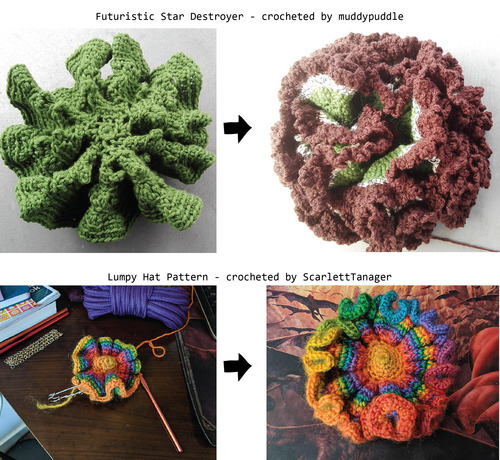
Here’s one rather innocently titled “Brim Hat Pattern #1708” which Ravelry user Persipan heroically crocheted all the way through the final row (or at least, halfway through that final row; we haven’t heard from them since, they’re probably okay). By Row 9, there are over 1700 stitches. Row 10 has 3500 stitches, took 9.75 hours to complete, and even that is nothing compared to the edging.
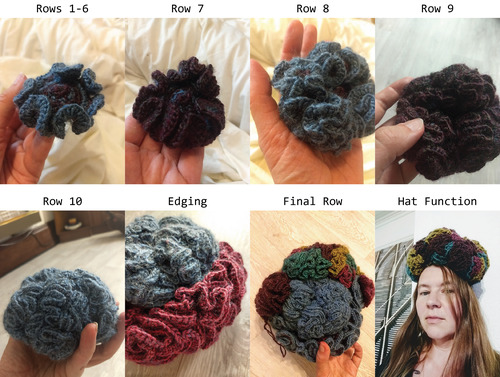
Almost all of HAT3000’s patterns did this, eating yarn, eating sanity, becoming more and more hyperbolic, threatening to collapse into black holes… why, since none of the example hats did this?
A few people explained it to me thus: It looks like it’s really hard for HAT3000 to NOT fill the planet with ruffly brains. Basically, since most hats are built from the center out, HAT3000 only knows how to make each circle bigger than the previous one, adding 1 new stitch for every 2 in the previous row, or, for the faster increases usually used at the center of a hat, as many as 5 or 8 stitches for every 1 in the previous row. That would still be okay if HAT3000 knew how to control its increases. Unfortunately, if it accidentally increases too much in 1 row, that excess increase gets multiplied by the next layer, which in turn gets multiplied again. The tiniest instability turns exponentially into yarn-eating disaster. Meanwhile, HAT3000 thinks it’s doing great because the pattern text itself is still very close match to what a human would do. It has no idea that its hat has exploded.
The worst offender is a pattern called simply “The End…” which by my calculations requires enough yarn to wrap the known universe in a ball of yarn about a billion light years thick.
Some of HAT3000’s patterns did actually produce hats, though they tended to all be tiny (probably because they had fewer rows and therefore fewer opportunities to begin suddenly expanding).
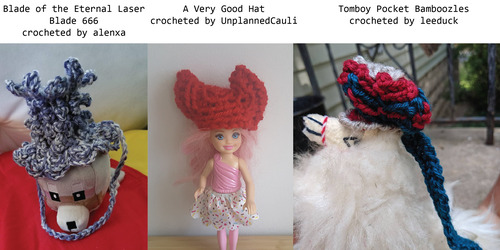
Other patterns produced not hats but strange artifacts, purpose unknown. Here’s the full pattern for one, called “Hang in Wind”:
Hang in Wind: Toss the pieces together. This is the windmill: Windmill in Wind: With a 1 cc ball of yarn, ch 14, join. Do not join, twist yarn to form a knot, or cut yarn.
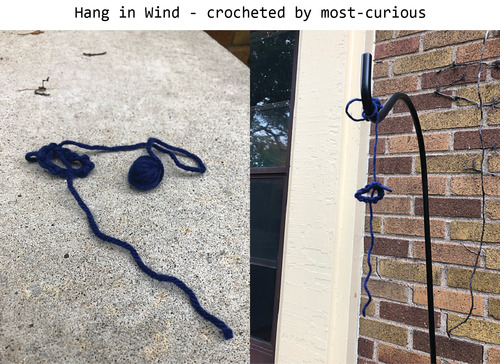
Other patterns were equally inscrutable.
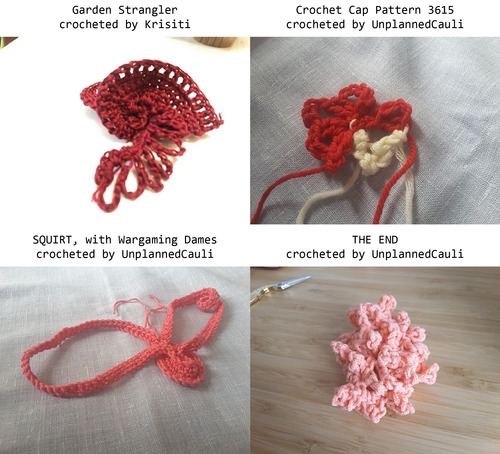
“New theory: HAT3000 didn’t want us to make hats for ourselves. We’re making hats for neural networks. Which are weird and amorphous and have dimensions and connections that humans cannot comprehend and also don’t really have heads.” - ScarlettTanager
One of the most entertaining aspects of the finetuned HAT3000 was how much of its original broad training it retained. Prompt it with the beginning of a story, and it could still add to the story in more or less the same style as the prompt. Hilariously, its strategy was now to gradually work the topic back toward crochet hats. In the paragraphs below, the prompt I gave HAT3000 is in bold. The AI did the rest.
Harry whirled to face Snape, heart beating hard. “Wh--What will you do?”
Snape’s eyes narrowed slightly and he lowered his wand, then stepped aside. As he approached behind Harry, he knelt down to kiss the front rim of Harry’s green-gloved hat as he pulled her closer. Snape slipped on the silk and reached in carefully, then unbuttoned Harry’s green-gloved hat. He looked Harry in the eyes and stroked her crown lightly before pushing on the seam of the hat to attach it. He finished on the front of Harry’s hat with a snap. With a light flourish he tied an extra strand of fabric, then another twist of silk, then another twist of silk.
HAT3000’s terrible crochet-themed erotica was even sometimes crochetable.
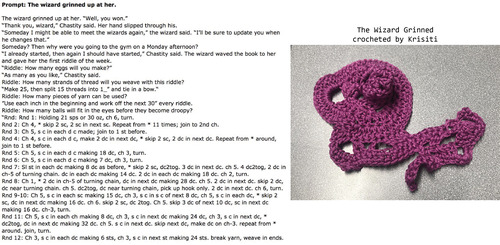
HAT3000 would sometimes turn its story prompts into things that were not crochet patterns exactly, but something strangely akin. Confrontations would turn into tightly choreographed fight scenes, the combatants weaving around and around each other. Villagers would build earthworks, walls, and moats in concentric circles. Recipes would turn into round cakes with dozens of stacked layers. Spaceships and adventuring heroes would follow complex and highly detailed routes. The trained model must have been able to draw some sort of connection between these various domains.
What have I learned from HAT3000? Like SkyKnit, it shows what unexpectedness happens when a neural net trainer, armed with approximately zero knowledge of a particular problem, nevertheless plows ahead and throws a neural net at it anyways. And like its knitting counterpart, HAT3000 owes its entire success to the creativity of human artists who took its often nonsensical patterns, fixed the bugs, and turned them into physical artifacts. I’d like to extend a huge thanks to the knitters and crocheters who sacrificed time, sanity, and yarn to satisfy the whims of these very weird AIs.
You can join the conversation, and crochet along, at the HAT3000 LSG thread (if you register first and don’t mind the swearing). There’s also a twitter thread that collects most of the patterns and many of the crocheted examples. There’s a big generated set of patterns here.
Subscribers get bonus content: I generated far more HAT3000 responses to story prompts than would fit in this post, but I picked some of my favorites to highlight as bonus material. I think they’re fascinating. If you have ever dreamt of a crossover between Star Wars/Harry Potter fan fiction and crochet, well YOU ARE IN LUCK.
You can order my book You Look Like a Thing and I Love You! It’s out November 5 2019.
Amazon - Barnes & Noble - Indiebound - Tattered Cover - Powell’s
2K notes
·
View notes
Text
I Want My Great Memory Back! http://yourgradgear.com/2017/09/27/i-want-my-great-memory-back/
New Post has been published on http://yourgradgear.com/2017/09/27/i-want-my-great-memory-back/
I Want My Great Memory Back!
Blanking on names? Left your iPhone in a cab? Our writer tests whether the latest science-backed recall tricks will really turn your mind into a steel trap.
Jancee Dunn
July 22, 2015
I used to have a memory that amazed people, but in the last few years I’ve had trouble remembering names and movie titles. (“You know, the one about the guy who goes somewhere? It won that award…”) I hope to have many years of sharp thinking ahead of meI’m in my mid-40s, nowhere near senior-moments territoryso I got to wondering: Is there something I should be doing now to counteract the lapses that already seem to be taking place?
There’s no way around the fact that memory erodes as we get older. The hippocampus, the area of your brain responsible for building memory, loses 5 percent of its nerve cells with each passing decade. Plus, aging slows production of acetylcholine, a neurotransmitter vital to learning and memory. Based on these facts, scientists once believed that a person’s mental ability peaked early in adulthood, then went downhill from there. But over the last few decades, research has found that adults’ brains are still able to form new, memory-building neural networks in a process known as neuroplasticity. The reassuring latest thinking: With a little effort, anyone can boost their power of recollection.
To test this theory in the real world, I tried an array of research-backed brain-sharpening techniques over one six-week period. Am I now able to list all 44 U.S. presidents? No. But can I more easily summon up where I put my keys? Yes. And I think being able to leave my apartment and lock the door is a more valuable life skill than remembering James K. Polk. Here’s what worked for meand what fell flat.
Technique #1: Play brain games
Puzzles like Sudoku and crosswords may improve memory and delay brain decline, though experts are not yet sure why. “My guess is that playing them activates synapses in the whole brain, including the memory areas,” says Marcel Danesi, PhD, author of Extreme Brain Workout. Research so far is decidedly mixed: Some studies have found that, while doing crossword puzzles may make you better at remembering the capital of Burkina Faso, there’s little evidence they’ll boost your performance at more general tasks, like remembering where your car is parked. But a 2011 study showed that participants who played a computer game called Double Decision for six years improved their concentration so much that they had a 50 percent lower rate of car accidents.
So I decided to try an online brain-training program called Lumosity, which neuroscientists from Harvard, Stanford and the University of California at Berkeley have used in their own studies; its creators claim that 97 percent of users improve their memory in just 10 hours of playing time. First I answered a series of questions at lumosity.com to identify which of my cognitive processes, including memory, could use a little help. Then I received a personalized training regimen. A 10-minute daily series of games is free, and a more advanced program is available for $12.95 a month. (Being cheap, I stuck with the former.) The games are pure funremembering a pattern of blocks, spotting a bird in a fieldand are based on what research has found to improve concentration and other cognitive skills.
My grade: B- By the end of a month, my “brain performance index” score rose 6 percentnot amazing in the Lumosity world, but respectable. The main problem: You have to play the games every day, forever, to keep up the benefits. I’ve mostly kept up. (Except on weekends. Or if I’ve had a busy week. OK, I haven’t kept up.)
Technique #2: Eat the right foods
According to Gary Small, MD, director of the UCLA Memory Clinic, memory superfoods include antioxidant-rich, colorful fruits and vegetables, which protect your brain from harmful free radicals. He’s also enthusiastic about low-glycemic carbs, like oatmeal, and anything with omega-3 fatty acids. In fact, a recent study published in Neurology found that people with low levels of omega-3s had brains that appeared to be a full two years older in MRI scans. That was incentive enough for me to follow the memory-enhancing diet from Dr. Small’s book The Memory Prescription, which claims it works in just two weeks. Much like the Mediterranean diet, it’s heavy on produce, legumes, nuts and fish. It’s low on meat, since meat’s omega-6 fatty acids may contribute to brain inflammation, a possible underlying mechanism for Alzheimer’s. Refined sugars produce a similar effect, so they were also out. (That was the toughest for me.) I ate a farmers market’s worth of blueberries, spinach, avocado and beets, and consumed enough fish to sprout gills. I also went beyond Dr. Small’s advice and took 2.4 micrograms of vitamin B12, the standard recommended daily amountsince studies show people with low levels perform poorly on memory testsand 1,000 international units of vitamin D, discovered by Tufts University researchers to boost cognitive function. (My doctor signed off on the supplements.)
My grade: A It was difficult to eat meat only once a week, until I noticed how much less physically and mentally sluggish I felt. And my memory became markedly sharper over 14 days. (For instance, I quit using a bookmark because I could remember the page number I’d stopped on the night before.) Planning those meals took a lot of prep, but it paid off tremendously. I still try to use the diet as a guideline: I eat meat once a week, aim for five fruits and vegetables a day and pop omega-3 supplements (since I don’t get as much fish as I did on the diet).
Next Page: Technique #3: Quit multitasking
[ pagebreak ]Technique #3: Quit multitasking
“One reason people can’t remember where their keys are is they’re not paying attention when they put them down,” says Mark McDaniel, PhD, a psychology professor and memory researcher at Washington University in St. Louis. (His suggestion for always finding them: “When you put them down, stop and say out loud, ‘I’m leaving my keys on my dresser,'” or wherever you’re placing them.) Studies show that it takes eight seconds to fully commit a piece of information to memory, so concentrating on the task at hand is crucial. I willed myself to stop giving everything “continuous partial attention,” a term coined by tech honcho Linda Stone. I put away my gadgets when they weren’t absolutely needed. I didn’t have 10 websites up all at once. I called a friend, sat on my bed, closed my eyes and actually listened to what she was saying.
My grade: B+ It’s amazing how difficult it is to do one thing at a time. Concentration takes work, but I found I could remember appointments better because I paid attention when I made them and repeated the day and time, rather than agreeing to commitments while doing the laundry and returning e-mail messages. My husband, usually my living iCal, was very impressed.
Technique #4: Master a new skill
A recent Swedish study found that adults who learned a new language showed improved memory for people’s names, among other things. Any activity that is practiced diligently, such as knitting or skiing, will likely have this effect, researchers say. I vowed to learn to play the keyboard. On YouTube I found PlayPianoKing, an affable guy who teaches everything from Pachelbel’s Canon to “Gangnam Style.”
My grade: C- While I did learn a mean “Gangnam” and felt my concentration improve, I soon gave up: With brain games and a diet overhaul crowding my schedule, the hour-long, every-other-day lesson was making me cranky, even before I saw any noticeable memory gains.
Technique #5: Get more sleep
Researchers at the University of Pennsylvania have discovered that losing half a night’s restthree or four hourson just one evening can erode memory. And the journal Nature Neuroscience recently reported that one way to slow decline in aging adults is to improve the length and quality of sleep. During a deep sleep of eight hours or more, it’s believed that the brain shifts memories from temporary to longer-term storage. Yet according to the Centers for Disease Control and Prevention, one third of us get less than seven hours a nightincluding me.
So, for more than a month, I implemented a stringent schedule: I would put my preschooler to bed and take a bath. Then I’d hit my own bed with a book, rather than watch TV or movies, which several studies reveal will make you feel too keyed up to wind down. Normally I fall asleep at 11:30 p.m. and wake at 5:45 a.m., but the new routine put me out by 10.
My grade: A+ Nothing had a better effect on my memory than that long stretch of sleep. I was able to semi-credibly measure the difference because I started my other interventions a few weeks before this one. I bounded out of bed fully recharged. My mind became as focused as a laser beam; I even remembered every mom’s name during the school run (no more “Hey, you!” or just “Hi!”).
Technique #6: Use mnemonic devices
These are basically memory tools that give meaning and organization to a random group of words or concepts. They could be an acronym (BOG for “Buy oranges and grapes”), an exaggerated visualization (imagining a massive stethoscope to remember a doctor’s appointment) or a rhyme (to recall a co-worker’s name, I’d remember, “Ted has a giant forehead”). Memory champions also love chunking, or breaking a large amount of information into more manageable nuggets. Say you have to memorize these numbers: 2214457819. It’s much easier to do as a phone number: 221-445-7819.
My grade: A+ I found these tactics enormously helpful. I usually forget my poor nephew’s birthday, but this year I actually sent a gift, thanks to the unpleasant but memorable NITS (“Nephew is 10 Sunday”).
Technique #7: Hit the gym
Researchers from the University of California at Irvine recently discovered that a little exercise might yield big mental benefits. They had one group of subjects ride stationary bikes for six minutes, while another group cooled their heels. Afterward, the active group performed significantly better on a memory test. Instant results! The researchers believe the boost may be tied to an exercise-induced brain chemical called norepinephrine, which has a strong influence on memory. And Dr. Small contends that exercise is the best memory aid of all. “It can increase your brain size,” he saysand the bigger your brain, the greater your capacity to remember. His recommendation: 20 minutes of brisk walking a day. I began doing an hour dailymore than Dr. Small recommends, but also more consistent than the gym workouts a few times a week I used to favor, and, according to many experts, more effective in juicing up memory.
My grade: A- This moderate, regular activity worked wonders on my stress levels, and it became much easier to concentrate afterward, so I could fix things (like a grocery list) into my memory. I grew addicted to my walks and still take them. In fact, I found that the memory-boosting healthy lifestyle habitsexercising more, stressing less, eating a better dietwere the most sustainable over time. And that’s a win-win.
You May Like
Source link
0 notes